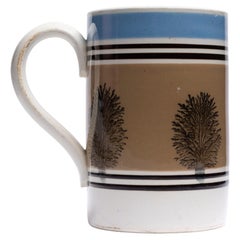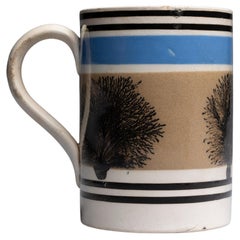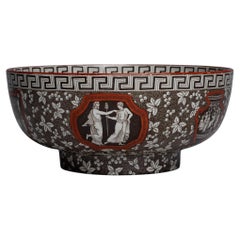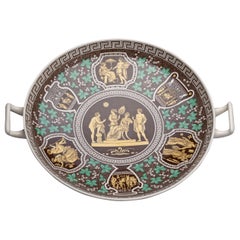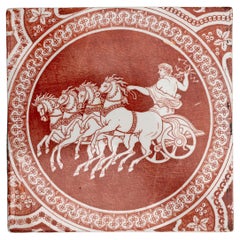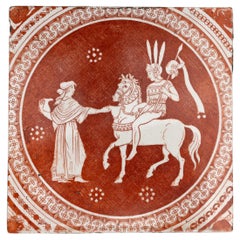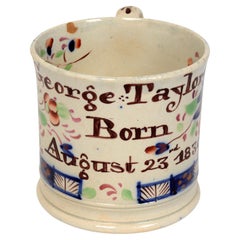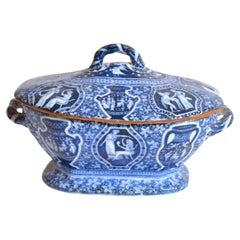Artistoric Pottery
to
1
12
2
10
4
3
12
10
3
2
2
12
11
10
6
1
1
12
12
12
2
2
2
2
1
Antique 19th Century English Mochaware Mug
Located in Fort Lauderdale, FL
An English mochaware mug with black and blue machine-turned bands and a tree pattern on a soft brown glaze.
This large mochaware mug features rouletted bands of black and blue frami...
Category
Antique Late 19th Century English Folk Art Pottery
Materials
Earthenware
Antique 19th Century English Mochaware Mug
Located in Fort Lauderdale, FL
An English mochaware mug with black and blue machine-turned bands and a tree pattern on a soft brown glaze.
This large mochaware mug features rouletted bands of black and blue frami...
Category
Antique Late 19th Century English Folk Art Pottery
Materials
Earthenware
19th Century Greek Revival Copeland Spode Bowl
By Copeland Spode
Located in Fort Lauderdale, FL
A vibrant Neoclassical Revival decorative bowl in the 'Greek' pattern made by Copeland Spode in the late 19th century.
Sir William Hamilton’s Collection of Etruscan, Greek and Roman antiquities, first published in 1766 by Pierre d’Hancarville, was a landmark publication in English design. It intended to disseminate the Antique style through its engravings of Attic pottery. The catalog’s faithful reproductions of Classical vases led British potteries, including Spode, to adapt or even copy the ancient art for modern life. This Copeland Spode Greek...
Category
Antique Late 19th Century British Neoclassical Revival Pottery
Materials
Earthenware, Pearlware
19th Century Copeland Spode Greek Tazza
By Copeland Spode
Located in Fort Lauderdale, FL
A brightly colored Neoclassical tazza or cake plate in the 'Greek' pattern made by Copeland Spode in the late 19th century.
This tazza, in Copeland Spode’s ‘Greek...
Category
Antique Late 19th Century British Neoclassical Revival Pottery
Materials
Earthenware, Pearlware
Early 19th Century Spode Red Greek Pattern Tile
By Spode, Josiah Spode
Located in Fort Lauderdale, FL
A Neoclassical red transferware tile made by Spode 1806-1810, with the ‘Zeus in His Chariot’ pattern.
Sir William Hamilton’s Collection of Etruscan, Greek and Roman antiquities, first published in 1766 by Pierre d’Hancarville, was a landmark publication in English design. It intended to disseminate the Antique style through its engravings of Attic pottery. The catalog’s faithful reproductions of Classical vases led British potteries, including Spode, to adapt or even copy the ancient art for modern life. These Spode Greek pattern tiles reflect the major influence of Hamilton’s catalog on English Neoclassicism. The central scene was taken directly from the catalog.
This tile can be dated to a narrow window of production in the Spode factory, 1806-1810. During that time, Spode used a technique known as the “Pluck and Dust” method to print in red transfer designs onto creamware. Using this method, source prints were transferred overglaze using tissue imprinted with a very faint rendition of the design outlined in sticky oil. The decorator applied the tissue to the object then carefully “plucked” or pulled it away, leaving the sticky oil design behind. Then, a finely-ground enamel color was “dusted” onto the surface, sticking to any areas that had the oil. A final firing at a low temperature in the enamel kiln made the pattern permanent. The Pluck and Dust technique improved upon bat-printing and enabled larger designers to be transferred. It was short-lived, however, as under-glaze transfer printing soon took over as the preferred method for producing transferwares.
Dimensions: 5 in. x 5 in. x 1/4 in.
Condition: Excellent.
Provenance:
The Collection of Nancy and Andrew Ramage
Jonathan Horne...
Category
Antique Early 19th Century English Neoclassical Pottery
Materials
Earthenware, Creamware
Early Spode Red Greek Pattern Tile
By Spode, Josiah Spode
Located in Fort Lauderdale, FL
A Neoclassical red transferware tile made by Spode 1806-1810, with the ‘Refreshments for Phliasian Horseman’ pattern.
Sir William Hamilton’s Collection of Etruscan, Greek and Roman antiquities, first published in 1766 by Pierre d’Hancarville, was a landmark publication in English design. It intended to disseminate the Antique style through its engravings of Attic pottery. The catalog’s faithful reproductions of Classical vases led British potteries, including Spode, to adapt or even copy the ancient art for modern life. These Spode Greek pattern tiles reflect the major influence of Hamilton’s catalog on English Neoclassicism. The central scene was taken directly from the catalog.
This tile can be dated to a narrow window of production in the Spode factory, 1806-1810. During that time, Spode used a technique known as the “Pluck and Dust” method to print in red transfer designs onto creamware. Using this method, source prints were transferred overglaze using tissue imprinted with a very faint rendition of the design outlined in sticky oil. The decorator applied the tissue to the object then carefully “plucked” or pulled it away, leaving the sticky oil design behind. Then, a finely-ground enamel color was “dusted” onto the surface, sticking to any areas that had the oil. A final firing at a low temperature in the enamel kiln made the pattern permanent. The Pluck and Dust technique improved upon bat-printing and enabled larger designers to be transferred. It was short-lived, however, as under-glaze transfer printing soon took over as the preferred method for producing transferwares.
Dimensions: 5 in. x 5 in. x 1/4 in.
Condition: Excellent. Slight chip to the upper left corner measuring approximately 0.9 cm. in length.
Provenance:
The Collection of Nancy and Andrew Ramage
Jonathan Horne...
Category
Antique Early 19th Century English Neoclassical Pottery
Materials
Earthenware, Creamware
Pair of Wedgwood & Bentley Agate Plant Pots
By Wedgwood & Bentley
Located in Fort Lauderdale, FL
A pair of plant pots covered in marbled brown glaze emulating agate gemstone encircled with checkered rims accented in gold, made circa 1770 by Wedgwood &...
Category
Antique 1770s English Neoclassical Planters and Jardinieres
Materials
Creamware, Pottery
$4,360 / set
Creil French Mochaware Pottery Coffee Pot
By Creil et Montereau
Located in Fort Lauderdale, FL
A Creil mochaware peach-colored coffee pot made circa 1810.
This elegant coffee pot features a dark brown mocha dendrite (tree) design on a light peach body. Mochaware pottery...
Category
Antique Early 19th Century French Folk Art Pitchers
Materials
Ceramic, Pottery
Early Wedgwood Egyptian Revival Neoclassical Rosso Antico Coffee Pot
By Josiah Wedgwood
Located in Fort Lauderdale, FL
A Wedgwood rosso antico coffee pot made ca. 1810. The pot's red body is accentuated by black basalt details in the Egyptian Revival style.
Developed by Josiah Wedgwood in the 1760s, rosso antico famously exhibits the Egyptian Revival style that became popular in the early 19th century during Napoleon...
Category
Antique Early 19th Century British Neoclassical Pitchers
Materials
Earthenware
Early 19th Century Wedgwood Egyptian Revival Rosso Antico Teapot
By Josiah Wedgwood
Located in Fort Lauderdale, FL
A rosso antico teapot made by Wedgwood ca. 1810. The pot's red body is accentuated by black basalt details in the Egyptian Revival style.
This ros...
Category
Antique Early 19th Century British Egyptian Revival Tea Sets
Materials
Earthenware
Six Wedgwood Majolica Argenta 'Lincoln' Pattern Dessert Dishes
By Wedgwood
Located in Fort Lauderdale, FL
Six Wedgwood majolica Argenta palette ‘Lincoln' pattern dessert plates with finely molded maroon prunus blossoms and dark taupe pine branches surrounded by a yellow Greek key border. The dishes are decorated in the japonisme style and feature the “Three Friends of Winter” motif, an Asian artistic convention showing the pine, plum, and bamboo together to represent steadfastness, perseverance, and resilience.
The Wedgwood factory introduced muted Argenta glazes to its majolicas in the 1880s to keep up with ever-changing fashions. The Argenta glaze color palette was more subdued than that of traditionally vibrant majolica, and was thus more appealing to the Aesthetic Movement japonisme style that pervaded the market. These Argenta majolica dessert dishes...
Category
Antique Late 19th Century English Japonisme Pottery
Materials
Earthenware, Majolica
$668 Sale Price
24% Off
Early 17th Century Ottoman Empire Iznik Pottery Dish
Located in Fort Lauderdale, FL
An Iznik pottery dish made in the first half of the 17th century and decorated with chrysanthemums and tulips. The rim features the rock and wave pattern.
Under the direction of O...
Category
Antique Early 17th Century Turkish Islamic Ceramics
Materials
Ceramic
Related Items
Early 19th c Gaudy Welch Personalised Commemorative Birthday Mug "George Taylor"
Located in valatie, NY
Early 19th c Gaudy Welch Personalised Commemorative Birthday Mug. "George Taylor Born August 23 1839." The term "Gaudy Welsh" refers to the style of brightly colored, heavily decorat...
Category
Antique Early 19th Century English Pottery
Materials
Pottery
Copeland Neo-classical Greek Pattern Blue Sauce Tureen & Cover
By Spode
Located in Downingtown, PA
Copeland-Late Spode Neo-Classical Greek Pattern Blue Sauce Tureen & Cover,
circa 1847.
From a large collection of Greek Pattern Objects- please inqui...
Category
Antique Mid-19th Century English Neoclassical Soup Tureens
Materials
Pearlware, Pottery
Spode Neo-Classical Greek Pattern Blue Oval Dessert Dishes
By Spode
Located in Downingtown, PA
Spode neo-classical Greek pattern blue oval dessert dishes,
"A Domestic Ceremony",
Early 19th century
The Spode Greek pattern pottery dishes a...
Category
Antique Early 19th Century English Neoclassical Pottery
Materials
Pottery, Pearlware
19th Century French Redware Tian Bowl
Located in Nantucket, MA
19th century French redware tian bowl with inside green glaze, serving spout, and natural finish on the exterior.
Traditionally used to prepare conf...
Category
Antique 19th Century French Pottery
Materials
Terracotta
Early Coffee Cup Blue and White Boy on a Buffalo Ptn probably Spode, circa 1790
By Josiah Spode
Located in Lincoln, Lincolnshire
This is a good, very early, rare blue and white coffee cup in the "Boy on a Buffalo" pattern, probably from the factory of Josiah Spode, stoke on Trent, Staffordshire, England, made...
Category
Antique Late 18th Century English Chinoiserie Ceramics
Materials
Earthenware
$274
H 2.5 in W 3.25 in D 2.38 in
Antique Copeland 91 Piece Spode Dinner Service 19th Century
By Copeland Spode
Located in London, GB
Extensive service of 19th century 81 piece Copeland Spode tablewares, with patterned borders and red-lined rims, with impressed marks for Copeland Spode.
Consisting of :
22 x Dinner...
Category
Antique 19th Century English Tableware
Materials
Porcelain
$1,158 / set
H 19.69 in W 15.36 in D 2.76 in
Copeland Spode Pottery Fox Hunt Lunch Service
Located in Essex, MA
A fox hunting set with all items listed below in the additional comments section.
Category
Early 20th Century English Pottery
Materials
Pottery
Late 19th Century Spanish Blue and White Fajalauza Bowl
Located in Tetbury, Gloucestershire
Late 19th Century Spanish blue and white Fajalauza pottery bowl from Granada.
Circa 1880.
Category
Antique 19th Century Spanish Pottery
Materials
Terracotta
Late 19th Century Spanish Blue and White Fajalauza Bowl
Located in Tetbury, Gloucestershire
Late 19th Century Spanish blue and white Fajalauza pottery bowl from Granada.
Circa 1880.
Category
Antique 19th Century Spanish Pottery
Materials
Terracotta
Late 19th Century Spanish Blue and White Fajalauza Bowl
Located in Tetbury, Gloucestershire
Late 19th Century Spanish blue and white Fajalauza pottery bowl from Granada.
Circa 1880.
Category
Antique 19th Century Spanish Pottery
Materials
Terracotta
Late 19th Century Spanish Blue and White Fajalauza Bowl
Located in Tetbury, Gloucestershire
Late 19th Century Spanish blue and white Fajalauza pottery bowl from Granada.
Circa 1880.
Category
Antique 19th Century Spanish Pottery
Materials
Terracotta
Antique Early 19th Century Spode Porcelain Pattern Number 2408 Tea Cup & Saucer
By Spode
Located in Philadelphia, PA
A fine antique Spode porcelain cup & saucer.
Pattern no. 2408
Decorated throughout with a cobalt floral patttern and extensive gilding.
Simply a great cup & saucer from Spod...
Category
Antique Early 19th Century English Neoclassical Porcelain
Materials
Porcelain
$295
H 2.63 in Dm 5.5 in
